HOME |
LOGBOOK |
|
Latitude:
05-33.097N; Longitude: 087-02.528W We caught no
fish. Every time Don would go to put the lure out, a booby would
show up. On our first day out we had a seriously bad booby day.
At 0630, just over the dicey part of our exit from Genovesa, a young
booby hooked himself and was being dragged until we could reel him
in. Fortunately it proved his upper bill was more wedged in the
hook than anything, and Don was able to shake him off with a little
judicious use of the pliers without major damage to his bill or
the new lure. Last we saw him he was upright in the water shaking
his head, obviously a little boggled from his experience. Unfortunately
our next booby incident around midday didn't end so well. What we
heard was a couple of thumps, and next thing a booby body dropped
into the water at my elbow! Our best guess is that he flew into
some rigging or maybe the wind generator and ricoche We allowed ourselves
to go very slowly the last day in order to approach Cocos in the
morning light as opposed to midnight. This prudence rewarded us
with a spectacular arrival. Around 4am the last bit of moon rose
with a bright planet alongside, and dolphins paralleled the boat
making comet-like vapor trails through the bioluminescent plankton
in the dark water. The island was black and mystical, rising steeply
to a cloud around the summit, and as dawn gradually broke i A little background.
Cocos, plus a dozen or so satellite rocks and islets, is one of
the premier diving destinations of the world. Belonging to
The diving had
been great. Similar to the Galapagos, the waters are thick with
fish, with 3-5' foot white-tip sharks as common as trumpetfish in
the Virgins and lobsters carpeting the rock faces (which may well
be a main reason we have to be shepherded by rangers!). Unlike the
Galapagos the water is warm enough for skins only and the visibility
is a clear 70', but there Briana left
Thursday for the Galapagos, leaving us all alone ...for about four
hours, the Okeanos Aggressor arriving to fill the void of the departed
Sea Hunter. Friday afternoon, Kaylor the park ranger picked us up
in the drizzle for our last dive and took us back to Isla Manuelita,
which is just north of Chatham Bay. This time we dove alone, Kaylor
having an ear infection; we deduce we have passed inspection as
divers. We had some misgivings about returning to Isla Manuelita,
the site of our first dive, but they were washed away by the best
critter turnout of all. Many, many MANY hammerheads, and QUITE CLOSE,
too! Two divers are clearly less intimidating to them than four
or six! It raises the question of who is watching whom? There were
actually more hammerheads on this dive than the ubiquitous white
tips! We must have seen ten marbled stingrays, swimming this way
and that or on the bottom, and five very large green turtles, three
of which were circling together (mating?) and two swam right up
to us curiously. For a grand finale....no, not the infamous whale
shark,..sigh...BUT that elusive underwater manta ray! We surfaced Saturday we dinghied around to Wafer Bay for a hike to Cacades Genio (like the genie in the lamp!). The park provided us with a guide, a thirty-one year-old engineer volunteer from Spain by name of Luis Sanchez. He proudly displayed to us his first contribution to the park, a supension bridge over a river made of steel cable, turnbuckles and chain-link fencing! From the bridge the path led through true rainforest -- this is primary growth rainforest and this is a 2 million year old island! -- and up the river course itself. It was perfect for these old Trini-trained waterfall-keteers, (Snake would have loved it!) and the conversations in Spanish on the way up made for great camouflage for the 2Cs' lack of conditioning! There was a lot of evidence of the destruction wrought by the islands' feral pigs rooting around in the moist soil to dig up roots. We also saw some neat birds, both males and females of the endemic Cocos finch, as well as a white dove that hovered overhead like a hummingbird. Luis said the Spanish conquistadores took them for the "espiritu santo!" and they were so otherworldy and out-of-place, that we could understand the impression. All the way up the upper course of the river were secondary falls leaking down the sides of whole hillsides. Still the "cascades" themselves, when we reached them, were superb. I'd guess a 100'+ drop into a pool from two separate falls, and the water temp -- unlike Trinidad -- was mild. You will have to take our word for all this as we discovered at the falls, that I had left the chip out of the digital camera! Back at the
boat, our anchorage had swelled to included five Costa Rican long-line
fishing boats. These are wooden craft about 30-45 feet in length,
all brightly painted with crews of four to six people aboard. From
the top stick up up to a dozen tall poles with garbage-bag "flags"
rather reminiscent of the Baptist residences in Trinidad, only these
poles are used to mark the long lines when they are deployed. When
we left for the hike, the crews were congregating for a game of
"football" on the low-tide beach. Don had given one crew
a lift to shore, and inquired if it was possible to buy fish. "Mas
tarde," they said. Well, upon our return the fishermen GAVE
us a huge wahoo, a 40 pounder, already beheaded and gutted! When
we pressed the subject of what we could give them in return, they
opted for cold pills...they all had th By dark there
were more than ten fishing boats and by morning fifteen. There are
only three other moorings in the harbor, so many of the boats instead
of anchoring tied up one behind the other making a string! It made
for a surreal night landscape for not only were the boats lit up
themselves, but the marker poles each had strobes On our last
day in harbor, Kaylor and Issaac came by to answer some questions
for for a potential article about the Park. In Kaylor's six years
as a Cocos Park ranger, he tells us he has never seen an assemblage
of fishing boats in Cocos like this. Apparently fishing has not
been good. Many Costa Rican boats have in the past edged in to Galapagos
waters. Now, with the aid of the US Coast Guard, Ecuador is clamping
down on this, and indeed several Costa Rican crews have been arrested.
Kaylor does much of the offshore patrolling, and he's up all night
making sure no fishing is happening with Some Internet
websites of interest:
|
|
home
| waypoints | logbook | reference shelf
|

 Our
364nm leg from Genovesa Island in the Galapagos to Cocos Island
was as gentle a trip as we have ever had. The weather was mostly
gorgeous and sunny, the water temperature steadily warming degree
by degree enabling the 2Cs to shed clothes layer by layer. We haven't
been in swimsuits underway since the Caribbean! The winds were light,
8-15 kts from behind us, and we sailed most of the way, resorting
to the engine only in the wee hours of the night when our speed
dropped below 4 kts. It was during one of these motoring sessions
that we had our only boat mishap. With a hefty pow, the exhaust
pipe flange blew clean off the engine dumping smoke and cooling
water into the bilge! The good news is that Captain Don had been
suspicious, and we were ready with replacement parts purchased when
Captain Gwen was in Ft. Lauderdale last February.
Our
364nm leg from Genovesa Island in the Galapagos to Cocos Island
was as gentle a trip as we have ever had. The weather was mostly
gorgeous and sunny, the water temperature steadily warming degree
by degree enabling the 2Cs to shed clothes layer by layer. We haven't
been in swimsuits underway since the Caribbean! The winds were light,
8-15 kts from behind us, and we sailed most of the way, resorting
to the engine only in the wee hours of the night when our speed
dropped below 4 kts. It was during one of these motoring sessions
that we had our only boat mishap. With a hefty pow, the exhaust
pipe flange blew clean off the engine dumping smoke and cooling
water into the bilge! The good news is that Captain Don had been
suspicious, and we were ready with replacement parts purchased when
Captain Gwen was in Ft. Lauderdale last February.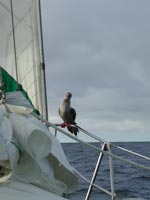 ted
off the mainsail. He landed head down and never moved. Very sad.
For this reason perhaps we were much more tolerant of the pair of
blue-footed boobies that rode through the night on our bow pulpit.
The fact that they will stay there with the sail luffing and snapping
amazes us. They were, however, unusually considerate, sitting with
their business ends forward over the water!
ted
off the mainsail. He landed head down and never moved. Very sad.
For this reason perhaps we were much more tolerant of the pair of
blue-footed boobies that rode through the night on our bow pulpit.
The fact that they will stay there with the sail luffing and snapping
amazes us. They were, however, unusually considerate, sitting with
their business ends forward over the water!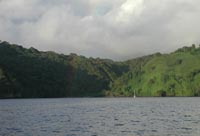 t
became greener and greener until it was a color so bright we couldn't
believe it. Dodging the seasons back and forth across the equator,
we'd completely forgotten what a dense tropical green could look
like, although in truth I don't think we've ever seen an island
this lush anywhere! Waterfalls actually burst from the sides and
tumble directly into the sea! (Opening scenes of Jurassic Park were
filmed here!) As we rounded the point into the Chatham Bay anchorage,
hundreds of frigate birds circled the boat along with dozens of
boobies, to the point camera work on the bow could be considered
risky business! Ahead in the bay was just one boat, our friends
Kathy and Bob on Briana. We picked up a mooring, had a bacon and
egg feast and a short snorkel just to remind ourselves what warm
water was, and had just dozed off in the cockpit when the park rangers
showed up to do business. Before we knew it we were all arranged
to do a dive that afternoon.
t
became greener and greener until it was a color so bright we couldn't
believe it. Dodging the seasons back and forth across the equator,
we'd completely forgotten what a dense tropical green could look
like, although in truth I don't think we've ever seen an island
this lush anywhere! Waterfalls actually burst from the sides and
tumble directly into the sea! (Opening scenes of Jurassic Park were
filmed here!) As we rounded the point into the Chatham Bay anchorage,
hundreds of frigate birds circled the boat along with dozens of
boobies, to the point camera work on the bow could be considered
risky business! Ahead in the bay was just one boat, our friends
Kathy and Bob on Briana. We picked up a mooring, had a bacon and
egg feast and a short snorkel just to remind ourselves what warm
water was, and had just dozed off in the cockpit when the park rangers
showed up to do business. Before we knew it we were all arranged
to do a dive that afternoon. 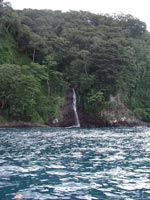 Costa Rica, it is entirely a Marine Park and is totally uninhabited
but for some park rangers and volunteers who reside in one of two
stations, a small one here in Chatham Bay, the other larger base
half-way around the north side of the island. There are no facilities
ashore for tourists, so all must come by sea. The bulk of visitors
to Cocos are scuba divers coming on one of two top-notch liveaboard
dive boats, the 115' Sea Hunter and the Okeanos Aggressor (the latter
at one time was skippered by my old Tropic Bird friend Dan Morrison.)
The other vessels that trickle in are either cruising boats like
ourselves, or fishermen, who, though they can't fish in the park
waters, are permitted to seek shelter here. The fees for cruisers
to be here are a bit steep, although not so steep as rumor had it.
For us it costs $15/day for the boat plus $15pp/day for us, which
is a total of $45 a day. About like being in a marina. For this
you have a nice mooring (yes, we checked all its attachment points!),
access to fresh water (they have a pipe rigged in a waterfall that
carries fresh water out to an offshore buoy!) and an onshore laundry
tub and showers, none of which we need on TII but which are welcome
amenities for many cruisers.
Costa Rica, it is entirely a Marine Park and is totally uninhabited
but for some park rangers and volunteers who reside in one of two
stations, a small one here in Chatham Bay, the other larger base
half-way around the north side of the island. There are no facilities
ashore for tourists, so all must come by sea. The bulk of visitors
to Cocos are scuba divers coming on one of two top-notch liveaboard
dive boats, the 115' Sea Hunter and the Okeanos Aggressor (the latter
at one time was skippered by my old Tropic Bird friend Dan Morrison.)
The other vessels that trickle in are either cruising boats like
ourselves, or fishermen, who, though they can't fish in the park
waters, are permitted to seek shelter here. The fees for cruisers
to be here are a bit steep, although not so steep as rumor had it.
For us it costs $15/day for the boat plus $15pp/day for us, which
is a total of $45 a day. About like being in a marina. For this
you have a nice mooring (yes, we checked all its attachment points!),
access to fresh water (they have a pipe rigged in a waterfall that
carries fresh water out to an offshore buoy!) and an onshore laundry
tub and showers, none of which we need on TII but which are welcome
amenities for many cruisers. 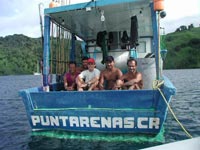 Diving
requires having all your own gear, including dive compressor. Fortunately,
since ours is still down from the failed hose in Galapagos, the
Sea Hunter was here and the very friendly captain filled all our
tanks for us. Then, as he was leaving on Monday, he went one step
further and lent us a fill hose for our compressor. The other hitches
with diving here are we must be accompanied by a park ranger and
we have to get there in our own dinghies. This puts us at the mercy
of the rangers' schedules and restricts our range to how far we
can practically get by rubber duck. However for $4/day it's a good
deal as you get a guide and, as all the dives are drift dives, a
chase boat that tows the dinghy along after you.
Diving
requires having all your own gear, including dive compressor. Fortunately,
since ours is still down from the failed hose in Galapagos, the
Sea Hunter was here and the very friendly captain filled all our
tanks for us. Then, as he was leaving on Monday, he went one step
further and lent us a fill hose for our compressor. The other hitches
with diving here are we must be accompanied by a park ranger and
we have to get there in our own dinghies. This puts us at the mercy
of the rangers' schedules and restricts our range to how far we
can practically get by rubber duck. However for $4/day it's a good
deal as you get a guide and, as all the dives are drift dives, a
chase boat that tows the dinghy along after you.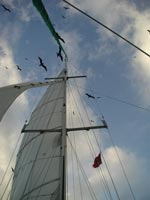 is
still very little coral, which we have since learned is thanks to
the disastrous El Nino of 1987. On one dive - Roca Sucia - we had
dolphins leaping around the dinghy topside and several schools of
hammerheads swirling around the underwater formations. Lot of marble
rays and turtles too. We've seen four huge Manta rays, but every
one of them was from topside. It seems they like to glide just inches
below the surface with their wing tips curling into the air! I did
managed to get in with one briefly on snorkle and we hope we got
a photo of another at least 12' wide! The downside of this paradise
is the amount of rain they receive -- 280" a year. There's
a reason it's green! Given that, it's been relatively nice weather
during the time we've been here, with only one full day of rain
and but two days of nasty roll! The rangers say the best time of
year is November through January.
is
still very little coral, which we have since learned is thanks to
the disastrous El Nino of 1987. On one dive - Roca Sucia - we had
dolphins leaping around the dinghy topside and several schools of
hammerheads swirling around the underwater formations. Lot of marble
rays and turtles too. We've seen four huge Manta rays, but every
one of them was from topside. It seems they like to glide just inches
below the surface with their wing tips curling into the air! I did
managed to get in with one briefly on snorkle and we hope we got
a photo of another at least 12' wide! The downside of this paradise
is the amount of rain they receive -- 280" a year. There's
a reason it's green! Given that, it's been relatively nice weather
during the time we've been here, with only one full day of rain
and but two days of nasty roll! The rangers say the best time of
year is November through January.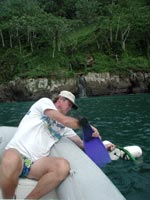 to find Kaylor and Gabriel shivering in the rain, so we brought
them home for hot chocolate (their choice). It was the one time
there were no English speaking rangers in the group, but it went
just fine. Don had fun showing them his engine room and the computer
charting, but they were most impressed with the solar panel installation.
to find Kaylor and Gabriel shivering in the rain, so we brought
them home for hot chocolate (their choice). It was the one time
there were no English speaking rangers in the group, but it went
just fine. Don had fun showing them his engine room and the computer
charting, but they were most impressed with the solar panel installation.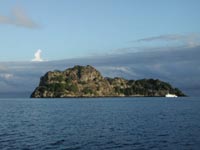 e
grippe! Don worked away steaking the fish, but even after filling
up the freezer we had so much fish left we gave the back half of
it to the park rangers! It was definitely a more effective way of
getting a fish than throwing all those lures in the water!
e
grippe! Don worked away steaking the fish, but even after filling
up the freezer we had so much fish left we gave the back half of
it to the park rangers! It was definitely a more effective way of
getting a fish than throwing all those lures in the water! firing
off! All this was quite educational for us as we learned quite a
bit about how they fish, how long the trolling lines are (1000 meters,
with 250 snap-on hooks along its length baited with squid) and what
to look for as markers when we cross paths with them at sea. We
certainly will feel more accommodating next time we encounter these
guys in our course!
firing
off! All this was quite educational for us as we learned quite a
bit about how they fish, how long the trolling lines are (1000 meters,
with 250 snap-on hooks along its length baited with squid) and what
to look for as markers when we cross paths with them at sea. We
certainly will feel more accommodating next time we encounter these
guys in our course!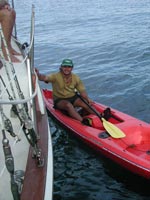 in
the eight-mile limit. Isaac told us, "Kaylor has many friends
(sic) in Punta Arenas who would like to kill him!" which immediately
answered our question of whether the fishermen regularly gave the
rangers fish like our wahoo. It is hard to imagine that we almost
didn't come here. It has been a special stop, not just for the beauty
of the island and the superb diving, but for some nice bridges between
interesting and different people. Today we prep the boat for our
eastward trek back to Panama. We should be underway at sunrise.
in
the eight-mile limit. Isaac told us, "Kaylor has many friends
(sic) in Punta Arenas who would like to kill him!" which immediately
answered our question of whether the fishermen regularly gave the
rangers fish like our wahoo. It is hard to imagine that we almost
didn't come here. It has been a special stop, not just for the beauty
of the island and the superb diving, but for some nice bridges between
interesting and different people. Today we prep the boat for our
eastward trek back to Panama. We should be underway at sunrise.
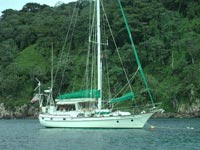 Even
more than in the Galapagos, the best way to visit Cocos is on a
liveaboard boat. Actually, it the only way! Okeanos and Sea Hunter
are both very top-notch ships, very oriented to high-tech scuba
diving, but they do make some provision for shore excursions and
kayaking etc. We are also told that the small cruise ships we saw
in the Galapagos do a couple of tours each year that include Cocos.
It is, however, hard for us to even imagine more than 20 people
here at a time! It's justnot that kind of place.The only other way
to spend time at Cocos, it to come as a volunteer, minimum commitment
being a month. You can get information about volunteering from the
Marine Park website.
Even
more than in the Galapagos, the best way to visit Cocos is on a
liveaboard boat. Actually, it the only way! Okeanos and Sea Hunter
are both very top-notch ships, very oriented to high-tech scuba
diving, but they do make some provision for shore excursions and
kayaking etc. We are also told that the small cruise ships we saw
in the Galapagos do a couple of tours each year that include Cocos.
It is, however, hard for us to even imagine more than 20 people
here at a time! It's justnot that kind of place.The only other way
to spend time at Cocos, it to come as a volunteer, minimum commitment
being a month. You can get information about volunteering from the
Marine Park website.
